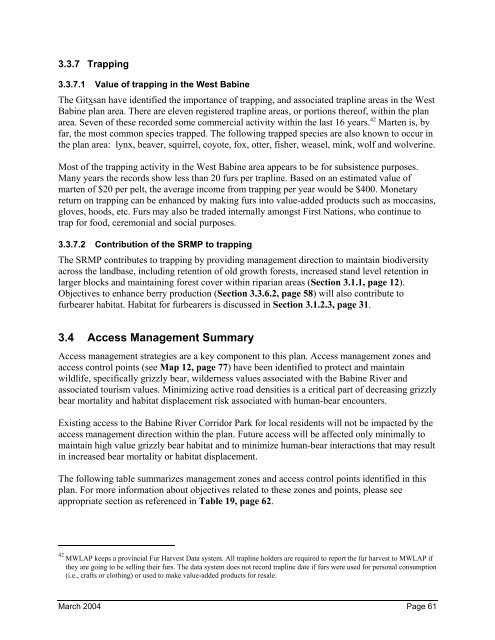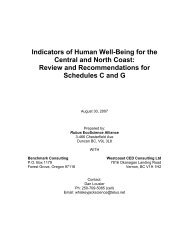West Babine Sustainable Resource Management Plan
West Babine Sustainable Resource Management Plan
West Babine Sustainable Resource Management Plan
You also want an ePaper? Increase the reach of your titles
YUMPU automatically turns print PDFs into web optimized ePapers that Google loves.
3.3.7 Trapping<br />
3.3.7.1 Value of trapping in the <strong>West</strong> <strong>Babine</strong><br />
The Gitxsan have identified the importance of trapping, and associated trapline areas in the <strong>West</strong><br />
<strong>Babine</strong> plan area. There are eleven registered trapline areas, or portions thereof, within the plan<br />
area. Seven of these recorded some commercial activity within the last 16 years. 42 Marten is, by<br />
far, the most common species trapped. The following trapped species are also known to occur in<br />
the plan area: lynx, beaver, squirrel, coyote, fox, otter, fisher, weasel, mink, wolf and wolverine.<br />
Most of the trapping activity in the <strong>West</strong> <strong>Babine</strong> area appears to be for subsistence purposes.<br />
Many years the records show less than 20 furs per trapline. Based on an estimated value of<br />
marten of $20 per pelt, the average income from trapping per year would be $400. Monetary<br />
return on trapping can be enhanced by making furs into value-added products such as moccasins,<br />
gloves, hoods, etc. Furs may also be traded internally amongst First Nations, who continue to<br />
trap for food, ceremonial and social purposes.<br />
3.3.7.2 Contribution of the SRMP to trapping<br />
The SRMP contributes to trapping by providing management direction to maintain biodiversity<br />
across the landbase, including retention of old growth forests, increased stand level retention in<br />
larger blocks and maintaining forest cover within riparian areas (Section 3.1.1, page 12).<br />
Objectives to enhance berry production (Section 3.3.6.2, page 58) will also contribute to<br />
furbearer habitat. Habitat for furbearers is discussed in Section 3.1.2.3, page 31.<br />
3.4 Access <strong>Management</strong> Summary<br />
Access management strategies are a key component to this plan. Access management zones and<br />
access control points (see Map 12, page 77) have been identified to protect and maintain<br />
wildlife, specifically grizzly bear, wilderness values associated with the <strong>Babine</strong> River and<br />
associated tourism values. Minimizing active road densities is a critical part of decreasing grizzly<br />
bear mortality and habitat displacement risk associated with human-bear encounters.<br />
Existing access to the <strong>Babine</strong> River Corridor Park for local residents will not be impacted by the<br />
access management direction within the plan. Future access will be affected only minimally to<br />
maintain high value grizzly bear habitat and to minimize human-bear interactions that may result<br />
in increased bear mortality or habitat displacement.<br />
The following table summarizes management zones and access control points identified in this<br />
plan. For more information about objectives related to these zones and points, please see<br />
appropriate section as referenced in Table 19, page 62.<br />
42 MWLAP keeps a provincial Fur Harvest Data system. All trapline holders are required to report the fur harvest to MWLAP if<br />
they are going to be selling their furs. The data system does not record trapline date if furs were used for personal consumption<br />
(i.e., crafts or clothing) or used to make value-added products for resale.<br />
March 2004 Page 61

















